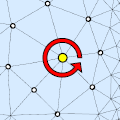|
CGAL 4.9.1 - Handles and Circulators
|
|
CGAL 4.9.1 - Handles and Circulators
|

The concept of iterators in the STL is tailored for linear sequences.
CGAL extends this in several directions. First, it supports the notion of Handle (also sometimes refered to as the trivial iterator) which is used to document that no traversal operation is needed, only reference to an element. It also uses the Range and ConstRange concepts which encapsulates the access to both the first and the past-the-end iterators of an iterator range.
Besides linear sequences, circular sequences also occur naturally in many combinatorial and geometric structures. Examples are polyhedral surfaces and planar maps, where the edges emanating from a vertex or the edges around a facet form a circular sequence.
We provide several functions, classes and macros to assist in working with circulators: distance computation, adaptor classes converting between circulators and iterators, base classes to ease the implementation of circulators, and support for generic algorithms that work with circulators as well as with iterators.
CGAL::Container_from_circulator<C>CGAL::Circulator_from_iterator<I>CGAL::Circulator_from_container<C>CGAL::Const_circulator_from_container<C> CGAL::Circulator_tagCGAL::Iterator_tagCGAL::Forward_circulator_tagCGAL::Bidirectional_circulator_tagCGAL::Random_access_circulator_tagCGAL::Circulator_baseCGAL::Forward_circulator_baseCGAL::Bidirectional_circulator_baseCGAL::Random_access_circulator_baseCGAL::Circulator_traits<C> Modules | |
| Concepts | |
| Adapters for Iterators and Containers | |
| Functions | |
| Compile Time Tags | |
| Iterators and circulators as well as different categories of circulators can be distinguished with the use of discriminating functions and the following circulator tags. | |
| Assertions | |
| Each of the following assertions, applicable to an iterator or a circulator or both, checks at compile time if its argument is of the kind stated in the assertions name, i.e. a circulator, an iterator, or a particular category of either an iterator or a circulator. | |
| Base Classes | |
| Implementation | |
Classes | |
| class | CGAL::Circulator_traits< C > |
| The circulator traits class distinguishes between circulators and iterators. More... | |